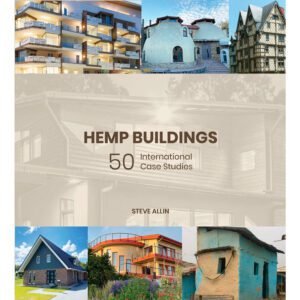Maximising profit margins through optimal harvesting
and post-harvest practices in hemp grain production
Dr Omid Ansari – HempGenTech
Hemp is a versatile crop that has a wide range of applications in various industries, including textiles, construction, food and beverages, and nutraceuticals. The right selection of a variety of hemp for grain production can play a significant role in determining grain yields and quality. In fact, it is estimated that the variety can account for 75-90% of the actual grain yield. Different hemp grain varieties have unique characteristics that impact the growth and development of the plant, including the height of the plant, the size and number of flowers, and the overall yield.
To achieve maximum yields, it is important for farmers to choose the right variety for their specific growing conditions and goals. Some varieties are better suited to areas with shorter growing seasons, while others may be better suited to regions with longer growing seasons and higher rainfall. Additionally, some varieties may be bred specifically for their grain yield, while others may be bred for their fibre quality. When selecting a variety of hemp grain, it is important to consider a number of factors, including the desired yield, the growing conditions, harvestability, maturity and the end use of the grain.
Another key factor that determines the quality and quantity of hemp production is the timing of harvest and post-harvest practices. The ideal time of harvest for hemp grain is crucial for maximising yield and profitability. The right timing depends on several factors, including the maturity of the plant, ease of harvesting, the climate, and the intended use of the crop.
In this article, we will discuss some factors to consider when harvesting hemp grains. Australia is becoming a significant producer of hemp, with the industry growing rapidly in recent years. Harvesting hemp grain on time and according to established protocols can bring significant benefits to farmers and the industry as a whole. One of the most significant benefits is an increase in the harvested grain (grain yield) and the quality of the crop. When hemp grains are harvested at the right time, hemp grain has the right moisture content, which results in better germination rates and higher yield. Additionally, grain harvested on time is less likely to be damaged, which results in a higher quality product that is more valuable.
Financial implications
The potential financial impact of harvesting hemp grain at the right time can be significant, with a difference of just a few days having a major impact on the yield and value of the crop. Based on the current average yield in Australia of ~800 – 2000 kg/ha and a seed value of ~$2-$4 per kg, the potential returns from a successful harvest can be substantial. For example, a harvest yielding 2000 kg/ha at the high end of the seed value range ($4 per kg) would result in a value of $8000 per ha. On the other hand, a harvest yielding 800 kg/ha at the low end of the seed value range ($2 per kg) would result in a value of only $1600. This represents a difference of $6400, highlighting the importance of harvesting hemp grain at the right time. Additionally, the financial impact of harvesting hemp grain too early or too late can be substantial. A harvest that is delayed by just a few days may result in lower yields and lower quality, which can result in a lower value for the crop. For example, a late harvest yielding 400 kg/ha (e.g., due to shattering) at the low end of the seed value range ($2 per kg) would result in a value of only $800. This represents a difference of $7200 compared to the optimal harvest of the right variety, highlighting the potential financial impact of harvesting hemp grain too late. The timing of hemp harvest is a critical factor in determining the yield and value of the crop. By harvesting hemp grain on time and according to established protocols, farmers can maximise their returns and ensure the profitability of their operations. Conversely, harvesting hemp grain too early or too late can result in lower yields, lower quality, and lower value, which can negatively impact the profitability of the operation.
 Time of harvest
Time of harvest
The ideal time for hemp seed harvest is when the plants have reached the physiological maturity stage. During this stage, the plant’s metabolism has slowed down and most seeds are fully formed and mature. To determine if the seeds are mature and the crop is ready for harvest, look for the following signs:
- Dryness: The seed heads should be dry to the touch and brittle.
- Colour: The seed heads should be a uniform brown colour (with no or a maximum of 20% green materials).
- Seed development: The seeds should be fully formed and not green or soft.
- Moisture content: The moisture content of the seeds is an important factor in determining when to harvest. Hemp seeds are typically harvested (direct heading) at a moisture content of around 15-20%. If the moisture content is too high, the seeds may spoil or be susceptible to mould. If the moisture content is too low, the seeds may be too brittle and break during threshing.
Field preparation
Before harvesting, ensure the field is free of any obstacles that may damage the combine or affect the harvest process. Ensure that the field is free of debris to avoid any clogging of the combine.
Combine preparation
Make sure the combine is in good working condition and equipped with a properly adjusted header, threshing system, and cleaning sieve. Check the header and sieves for any damage or wear and replace or repair them if necessary. We recommend following these steps to properly clean and prepare the combine before hemp seed harvest.
- Pre-harvest inspection: Before beginning the harvest, inspect the combine thoroughly to ensure that it is in good working condition. Look for any signs of damage or wear, including damaged or worn header or sieve components, worn or damaged threshing components, and other issues that may affect the harvest.
- Lubrication: Lubricate all moving parts of the combine, including the header, threshing components, and cleaning sieve, to ensure efficient operation and reduce wear and tear.
- Repair and replacement: If any components are damaged or worn, replace or repair them as necessary. This may include replacing damaged header or sieve components, repairing or replacing worn or damaged threshing components, and fixing any other issues that may affect the harvest.
- Cleaning: Clean the combine thoroughly before starting the harvest. This may include removing any plant material, dust, or other debris that may have accumulated during the growing season. Clean the header, threshing components, and cleaning sieve to ensure efficient operation during the harvest.
To avoid minimising seed contamination during hemp seed harvest, it is important to look for and remove any other seeds that may be present in the harvest. Here are some key areas to focus on based on HGTs experts’ opinions:
- Header: Check the header for any other seeds that may have been harvested along with the hemp seeds. This may include weed seeds, other crop seeds, or seeds from volunteer plants. Remove any other seeds that are present and dispose of them properly.
- Threshing system: Check the threshing system for any other seeds that may have been separated from the hemp seeds. This may include weed seeds, other crop seeds, or seeds from volunteer plants. Remove any other seeds that are present and dispose of them properly.
- Cleaning sieve: Check the cleaning sieve for any other seeds that may have been separated from the hemp seeds. This may include weed seeds, other crop seeds, or seeds from volunteer plants. Remove any other seeds that are present and dispose of them properly.
- Storage containers: Check the storage containers for any other seeds that may have been harvested with the hemp seeds. This may include weed seeds, other crop seeds, or seeds from volunteer plants. Remove any other seeds that are present and dispose of them properly.
Begin harvesting at a moderate speed, around 5-10 km/h, to ensure that the seed heads are properly threshed and separated from the plants. Adjust the header and threshing system as needed to optimise seed separation and minimise damage to the seeds. Follow the guidelines of this article for the successful harvesting of hemp seeds.
Threshing system adjustment
Adjust the threshing system to ensure that the seed heads are properly threshed and separated from the plants. This may involve adjusting the concave clearance, rotor speed, and drum or cylinder speed. To adjust the threshing system for hemp, follow these steps:
- Determine the hemp variety: Different varieties of hemp have different grain sizes and ratios of the hull to heart. This may affect the adjustments needed for the threshing system. Before adjusting the threshing system, determine the variety of hemp being harvested and consider its unique grain size and hull: heart ratio.
- Concave clearance: The concave clearance is the distance between the threshing rotor and the concave. For hemp seed harvest, a concave clearance depends on the seed size. This clearance should allow the seed heads to be properly threshed and separated from the plants. If the concave clearance is too small, the seed heads may not be properly threshed. If the concave clearance is too large, the seed heads may be damaged during threshing.
- Rotor speed: The rotor speed refers to the speed at which the threshing rotor is rotating. A rotor speed of ~550 RPM is commonly used for hemp seed harvest. This speed ensures that the seed heads are properly threshed and separated from the plants. If the rotor speed is too slow, the seed heads may not be properly threshed. If the rotor speed is too fast, the seed heads may be damaged during threshing.
- Drum or cylinder speed: The drum or cylinder speed refers to the speed at which the drum or cylinder is rotating. This speed may also need to be adjusted to ensure that the seed heads are properly threshed and separated from the plants. The ideal drum or cylinder speed will depend on the specific hemp variety being harvested, as well as the concave clearance and rotor speed.
By adjusting the threshing system, you can ensure that the seed heads are properly threshed and separated from the plants during hemp seed harvest. Keep in mind that these guidelines are just that, and the ideal settings for your specific harvest may vary based on factors such as the hemp variety, grain size, and hull: heart ratio. It may be helpful to experiment with different settings to determine the best threshing system adjustments for your specific harvest.
Airflow adjustment
The airflow system helps to separate the seed from the chaff and other debris. Adjust the airflow to ensure that the seed is effectively separated and carried to the cleaning sieve. Steps to adjust the airflow system for hemp seed harvest:
- Determine the hemp variety: Different varieties of hemp have different grain sizes. This may affect the adjustments needed for the airflow system. Before adjusting the airflow, determine the variety of hemp being harvested.
- Adjust fan speed: The fan speed controls the air flow rate. To increase the airflow rate, increase the fan speed. Use the measured air flow rate to adjust the fan speed until it falls within the recommended range.
- Monitor airflow: After adjusting the fan speed, monitor the air flow rate and ensure that it remains within the suggested range. If the airflow rate falls outside of this range, make additional adjustments to the fan speed as needed.
Often it is suggested to decrease the fan speed as low as possible, and yes, we would recommend decreasing the fan speed as low as possible as well while still effectively separating the seed from the chaff and other debris. By reducing the fan speed, you can decrease the air resistance, which can reduce seed damage and help preserve the quality of the seed.
However, it is important to find the balance between reducing fan speed and maintaining effective separation. If the fan speed is too low, the seed may not be effectively separated and may result in contamination with chaff and other debris. On the other hand, if the fan speed is too high, it may cause seed damage and reduce the overall quality of the harvest.
Cleaning sieve
As the harvested seed heads enter the combine, they will pass through the cleaning sieve to remove any remaining plant material, dust, and other debris. Check the cleaning sieve regularly and adjust as needed to ensure efficient cleaning. Cleaning the harvested hemp seeds is not only important for producing high-quality seeds, but it is also critical for producing certified seeds. Certified seeds are seeds that meet specific standards for quality, purity, and germination rate, and are used for planting new crops. In order to produce certified seeds, it is essential to ensure that the seeds are free from contaminants, including any remaining plant material, dust, and other debris. Proper cleaning of the harvested seeds is the first step in ensuring that the seeds meet the standards for certified seeds. Additionally, the cleaning process is typically followed by a series of tests and inspections to verify the quality and purity of the seeds. These tests may include laboratory analysis to check for seed viability, germination rate, and purity, as well as visual inspections to check for contaminants and other quality issues.
Overall, the cleaning and processing of harvested hemp seeds is a critical step in the production of certified seeds, and it is essential to follow proper cleaning procedures and guidelines to ensure the quality and purity of the seeds. By producing certified seeds, growers can help to ensure that their crops are of high quality and meet the standards required for planting new crops.
Monitoring
Monitor the combine regularly for any signs of damage or wear and perform any necessary repairs or maintenance as soon as possible. Keep an eye on the combine’s performance to ensure efficient seed separation and cleaning.
Fire incidence during hemp harvest or drying
The incidence of fire during harvest and drying is a significant concern. This is due to several factors, including the high heat associated with hemp biomass, as well as the high oil content of the seeds. Hemp seeds contain a significant amount of oil, which is flammable when exposed to high temperatures and dry conditions. To minimise the risk of fire during hemp seed drying, it is essential to follow a set of precautionary protocols. These protocols should include regular monitoring of the drying equipment, as well as the environment, to detect and respond to any signs of fire. Additionally, proper ventilation should be provided to minimise the risk of fire, and fire suppression equipment should be readily available and in good working condition. It is also important to properly maintain and calibrate the drying equipment, to ensure that it is functioning correctly and not producing sparks or other ignition sources. Operators should be properly trained in the use of the equipment and in the detection and response to fire, and they should follow all safety procedures and protocols when working with hemp biomass and seeds.
Environmental factors
The success of hemp grain harvest depends on carefully monitoring the environmental conditions during the harvesting process. Here are some suggestions to consider during the harvest.
- Dewpoint Level: Dewpoint level for harvesting hemp grain is at a level to prevent seed moisture absorption and reduces the risk of seed damage.
- Air Temperature: Optimal air temperature for harvesting hemp grain is above 15°C (where possible) to reduce the risk of seed damage.
- Wind Speed: Ideal wind speed for harvesting hemp grain is below 20 Kph to prevent seed loss and damage. High wind speeds can cause seed loss and damage to plants.
Collection, transport, and storage
Collect the cleaned seed in a hopper or storage container and keep it in a cool, dry place to preserve seed quality. It is vital to transfer the harvested seeds to a proper storage facility as practically as possible to preserve their quality and viability. The seed must be kept in a cool, dry place to ensure its longevity and viability. Here are some guidelines to consider when storing cleaned hemp seeds:
- Temperature: The ideal storage temperature for cleaned hemp seeds is between 0°C to 5°C but this may not be possible at a commercial scale. If not possible to maintain within this temperature range, seeds should be stored away from heat sources and direct sunlight to avoid temperature fluctuations. High temperatures can cause the seeds to dry out and reduce their viability.
- Humidity: Cleaned hemp seeds should be stored in an environment with low humidity, ideally below 10%. High humidity levels can cause mould growth and other forms of seed degradation. Maintaining a steady moisture level at the seed storage facility to maintain the longevity of hemp seeds is essential.
- Light: Cleaned hemp seeds should be stored in a dark place, away from direct sunlight and artificial light sources. Light can cause the seeds to dry out and lose their viability.
- Airflow: The storage rooms should allow for proper airflow (this is different from small quantities of seeds that are kept at genebanks or for research purposes) to prevent mould growth and other forms of seed degradation.
- Container: The storage container should be airtight, clean, and moisture-resistant to prevent moisture from entering and causing seed degradation.
Post-harvest processing
Once the grain is harvested and stored, it needs further processing to remove any remaining plant material or debris. This can be done through screening/ grading, winnowing, etc. The harvested seed should be transferred to the drying facility as soon as possible as any delay could result in a reduction of seed viability and quality. Harvested hemp seed cannot be held as long as corn due to its susceptibility to spoilage and degradation when exposed to moisture. Unlike corn, which is relatively robust and can be stored for longer periods of time, hemp is more delicate and can easily be damaged when exposed to moisture. This makes it essential to dry hemp seeds as soon as possible after harvest to preserve seed viability and quality. Any delay in drying the hemp seeds can lead to a rapid reduction in seed viability and oil quality, which can negatively impact the overall quality of the hemp seed oil. The exposure of hemp seeds to higher temperatures and moisture can have a significant impact on seed viability, protein and oil content, and composition.
The following are general statements about the effects of temperature and moisture on hemp seeds, protein and oil contents:
- Temperature: Exposure of hemp seeds to higher temperatures can increase the rate of seed respiration, which can reduce seed viability and oil quality. In addition, elevated temperatures can lead to the degradation of seed proteins, reducing their nutritional value.
- Moisture: Exposure of hemp seeds to moisture can lead to seed moisture absorption, which can cause seed germination and reduce seed viability. High moisture levels can also promote the growth of mould and bacteria, which can further reduce seed quality and oil composition.
The protein content of hemp seeds is a critical factor in determining seed quality and nutritional value. The exposure of hemp seeds to elevated temperatures and moisture levels can lead to the degradation of seed proteins, reducing the total protein content of the seeds. Similarly, hemp seeds are a rich source of oil, which is used for a variety of industrial and food applications. The exposure of hemp seeds to elevated temperatures and moisture levels can reduce oil quality and quantity, leading to a reduction in the overall oil content of the seeds. The composition of the hemp seed oil is critical for its various industrial and food applications. Exposure to elevated temperatures and moisture levels can cause changes in the composition of hemp seed oil, which can affect its stability, nutritional value, and suitability for various applications.
Hemp seeds are smaller than corn kernels, which can create additional challenges during the drying process. The smaller size of the seeds means that there is less space between them, which can increase resistance to airflow and make it more difficult to achieve an even and efficient drying process. This can result in longer drying times and an increased risk of spoilage or degradation due to moisture exposure. To mitigate these challenges, it is essential to use specialised equipment that is designed to handle the smaller size of hemp seeds, such as seed dryers with smaller sieves and air flow systems that can effectively move the seeds through the drying process. This can result in longer drying times and an increased risk of spoilage or degradation due to moisture exposure. To mitigate these challenges, it is essential to use specialised equipment that is designed to handle the smaller size of hemp seeds, such as seed dryers with smaller sieves and air flow systems that can effectively move the seeds through the drying process. Additionally, it may be necessary to adjust the drying parameters, such as temperature and airflow, to accommodate the smaller size of the seeds and to minimize the risk of damage or degradation.
Drying hemp seeds – commercial quantities
When it comes to drying commercial quantities of hemp seeds, there are different approaches that can be used. Some of the traditional options include batch or continuous drying systems, on-farm mobile drying, and aerated silos. There are several options for drying harvested hemp seed – some are listed below:
- Aerated silos: This system uses airflow to dry the seed inside a large storage container. The seed is placed in the silo, and a fan circulates air to reduce the moisture content. This method is effective for small to medium-scale operations, as it is cost-effective and can be automated to a certain extent.
- Batch drying systems: This system uses a batch drying bin, where the seed is placed in a large container, and the air is circulated around the seed until the desired moisture content is reached. This method is effective for small to medium-scale operations and can be automated.
- Continuous drying systems: This system uses a continuous flow dryer to reduce the moisture content of the seed. The seed is placed in a hopper, and the air is circulated through the seed as it moves through the dryer. This method is more effective for larger-scale operations, as it is more efficient and can handle larger
volumes of seed. - On-farm mobile drying: This system uses a mobile drying unit, which is placed on a trailer and can be moved from one location to another. This method is suitable for farmers who have limited storage space, as the unit can be moved to different locations as needed.
- Heated air systems: In high-moisture environments, heated air can be used to speed up the drying process and reduce the risk of mould or other contaminants. Heated air-drying systems work by circulating hot air over the seed to remove moisture. The temperature and relative humidity of the air can be controlled to ensure that optimal drying conditions are maintained. The use of heated air in high moisture environments is a common practice in seed drying, and it can be used in combination with any of the drying systems mentioned above, such as aerated silos, batch drying systems, continuous drying systems, and on-farm mobile drying units. It is important to monitor the seed temperature and moisture content during the drying process, and to adjust the temperature and airflow as needed to ensure that the seed is dried evenly and to the desired moisture content. Excessive heat and/or extended exposure to high temperatures can damage the seed and reduce its viability, so it is important to use caution and follow the manufacturer’s guidelines when using heated air for seed drying.
- Microwave-assisted drying: This drying method uses microwave energy to rapidly remove moisture from the seeds. This approach can be very efficient, but it may also be more expensive and may result in some degradation of the seed quality.
Drying hemp seeds – small quantities for research and breeding purposes
There are several options available for drying small quantities of hemp seeds for research purposes:
- Oven drying: One of the simplest methods for drying small quantities of seed is to use a laboratory oven. The seeds can be spread out on a tray and dried at a low temperature, such as between 40-50°C, for several hours.
- Desiccant drying: Another option is to use a desiccant material, such as silica gel, to absorb moisture from the seeds. The seeds can be placed in a container with the desiccant, and the container can be sealed to prevent moisture from reentering.
- Dehumidifier drying: A dehumidifier can be used to dry the seeds by removing moisture from the air. The seeds can be placed in a container with a dehumidifier, and the relative humidity of the air can be monitored to ensure that it remains low.
- Sun drying: Sun drying is another option for small quantities of seed, but it should only be used in dry, warm, and sunny conditions. The seeds can be spread out on a tray or shade cloth and left to dry in direct sunlight for several hours.
- Air drying: Air drying is a simple and straightforward method for drying small quantities of seed, but it requires a warm and dry environment. The seeds can be spread out on a tray or cloth and left to air dry for several days.
- Microwave drying: This is a quick and convenient option for drying small quantities of hemp seeds. However, it is important to monitor the process carefully as the high heat can damage the seeds if left unchecked.
- Vacuum drying: This method uses a vacuum to remove the moisture from the seeds. It is gentle and effective for drying small quantities of hemp seeds but requires specialised equipment.
- Freeze drying: This method involves rapidly freezing the seeds and then removing the moisture through a process of sublimation. This is an effective method for preserving the quality and viability of the seeds but requires specialised equipment.
- Solar drying: This method involves exposing the seeds to direct sunlight and airflow to evaporate the moisture. This is an eco-friendly option but may not be feasible in regions with limited sunlight.
- Dehydrator: This is a machine that uses heat and airflow to remove moisture from the seeds. This is a convenient option for drying small quantities of seeds but may not be suitable for large quantities.
It is important to monitor the seed temperature and moisture content during the drying process, and to adjust the drying conditions as needed to ensure that the seed is dried evenly and to the desired moisture content. Over-drying or exposure to excessively high temperatures can damage the seed and reduce its viability, so it is important to use caution and follow best practices for seed drying.
WARNING: these are my personal opinions only. The material presented in this report is the intellectual property of HempGenTech Pty Ltd.
Dr Omid Ansari




 Jaimie Milling is a fourth-generation farmer who has been in the agriculture industry all his life.
Jaimie Milling is a fourth-generation farmer who has been in the agriculture industry all his life.
 We are grateful to the
We are grateful to the  The AIHC was conceived and designed by its founder, Robert Bell, to both add value and to assist in the future expansion of the industrial hemp industry and its community.
The AIHC was conceived and designed by its founder, Robert Bell, to both add value and to assist in the future expansion of the industrial hemp industry and its community.




 As the Deputy CEO of the Northern Territory Farmers Association (NT Farmers), I am committed to advancing agricultural development in Northern Australia.
As the Deputy CEO of the Northern Territory Farmers Association (NT Farmers), I am committed to advancing agricultural development in Northern Australia. 










 Health
Health

 AVAILABLE PLANTING SEED:
AVAILABLE PLANTING SEED: Our Top 5 Cultivars have been developed without genetic modification to grow and thrive in most regions of Australia.
Our Top 5 Cultivars have been developed without genetic modification to grow and thrive in most regions of Australia.